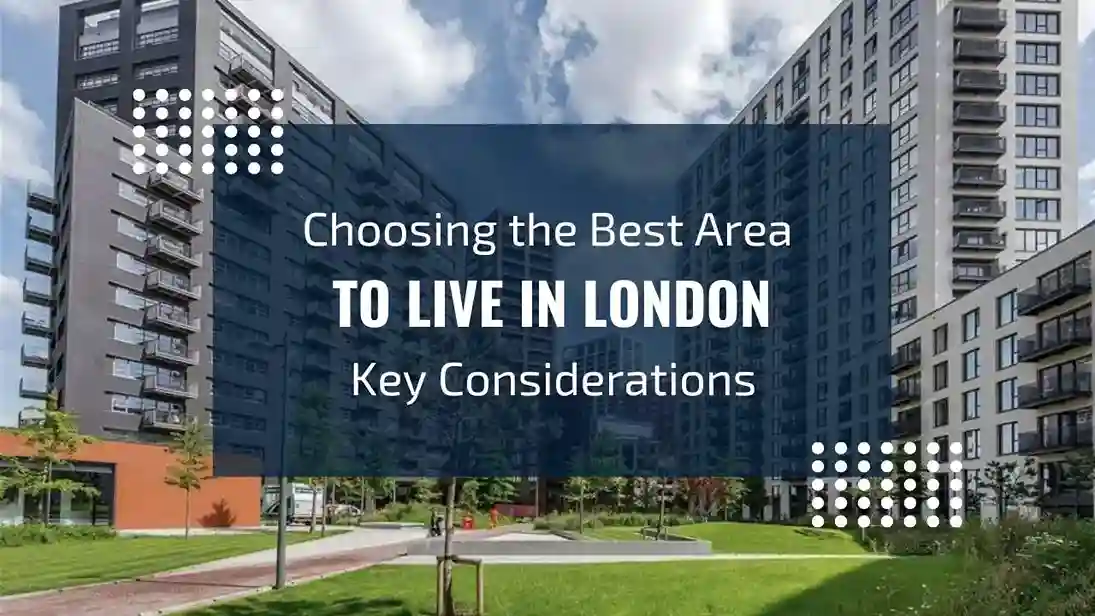Introduction
Choosing the right area to live in London is one of the most important decisions you’ll make. With the city’s diverse neighborhoods, varying property prices, and distinct lifestyles, it’s essential to evaluate your needs, preferences, and budget. Whether you are moving to London for work, study, or family reasons, understanding the factors that influence your choice will help you find the perfect location to call home. From crime rates to transport links, schools, medical facilities, and resale value, the following guide will help you navigate the many considerations of choosing where to live in London.

What Does It Mean to Live in London?
Understanding the Different Environments in London
Living in London means choosing between a variety of neighbourhoods, each offering a different experience. The city is a mix of fast-paced city center areas and serene, leafy suburbs. Whether you’re looking for a vibrant, bustling environment or a quieter place to call home, the key is understanding your priorities. Some may prefer the convenience of living close to work or entertainment, while others might want easy access to parks, quiet streets, and a family-friendly atmosphere.
Before you begin your property search, it’s important to consider which type of environment you want to live in London. Ask yourself whether you thrive in the city’s hustle or desire a peaceful retreat, and weigh your preferences for commute time, green spaces, nightlife, and proximity to schools or work.
How to Choose the Best Area to Live in London
When choosing where to live in London, there are several important factors you need to take into consideration to find the perfect neighborhood. It’s important to balance your personal preferences with practical concerns like transport links, local amenities, and long-term investment potential. Here’s how to start:
1. What Type of Neighborhood Do You Want to Live In?
The first step in finding your perfect location is determining the type of area that best suits your lifestyle. London offers a variety of neighborhoods, each catering to different needs:

- Urban City Center: Do you prefer a vibrant, fast-paced environment with easy access to shops, restaurants, and entertainment? Areas like Soho, Covent Garden, and Shoreditch offer a lively social scene and close proximity to workspaces.
- Residential Suburbs: For those seeking a more relaxed pace of life, neighborhoods such as Hammersmith, Chiswick, or Richmond offer excellent residential options with green spaces and family-friendly amenities.
- Mixed Urban-Suburban: If you want to combine easy access to both city life and suburban tranquility, areas like Stratford, Islington, or Hackney offer a good mix of both.
By understanding what matters most to you – whether it’s nightlife, quiet green spaces, or easy access to your workplace – you can narrow down the areas that will best meet your needs.
2. How Are the Transport Links in the Area?
The Impact of Transport Links on Your Daily Life
Transport plays a major role in determining the convenience of living in London. Whether you’re using public transportation or driving, proximity to transport hubs can significantly influence your daily commute and overall quality of life.
Central Areas: For those working in the heart of London or needing fast access to the City, choosing a location near underground or overground stations is essential. Areas like Paddington, King’s Cross, and Waterloo are prime spots due to their excellent connectivity, making commuting quick and easy.
Suburban Areas: On the other hand, more affordable areas on the outskirts, like Ilford, Barking, or Walthamstow, may offer lower housing prices but come with longer commute times. However, these locations are often well-connected to Crossrail stations, ensuring smoother future travel across London.
When considering transport links in an area, here are some important questions to ask:
- How close are the public transport stations?
- What is the average commute time to your workplace or university?
- Are any new transport projects planned to improve connectivity?
In the end, the right area with excellent transport links can make a significant difference in your daily routine.
3. What About Local Amenities?
Besides transport, it’s essential to consider access to essential services and amenities. For example, if you have children, you’ll want to check the quality of local schools, medical facilities, and recreational options.
- Schools: For families, access to good schools is critical. Ofsted provides school ratings, which can help you evaluate schools in different areas. Popular family-friendly neighborhoods like Richmond and Barnet boast excellent schools.
- Medical Facilities: Ensure that there are nearby medical facilities such as GP clinics, pharmacies, and hospitals. Central London areas tend to have larger hospitals, while suburban areas offer local GP clinics.
- Safety and Crime Rates: Safety is a key concern for many when deciding where to live. Use online resources like police.uk to check crime rates in various neighborhoods and make an informed decision.
4. How Is the Property Market in the Area When You Live in London?
Understanding Property Prices and Investment Potential in London
Before committing to a location in London, it’s essential to evaluate the property market in the area. Property prices in London can vary greatly from one neighborhood to another, and understanding trends in price fluctuations can help you make a more informed decision.

Up-and-Coming Areas: Certain neighborhoods like Barking, Stratford, and Woolwich are undergoing significant regeneration projects, making them ideal for buyers looking to invest before prices rise. These areas often offer lower property prices initially but have the potential for substantial price increases as the area becomes more popular. If you purchase in these neighborhoods early, you might see a high return on investment as demand grows.
Established Areas: In contrast, more established areas like Chelsea, Notting Hill, and Kensington have seen stable growth over the years, but property prices remain high. While these areas offer long-term stability and strong investment potential, they come with a hefty price tag. For those seeking a solid, long-term investment in property, these neighborhoods are reliable choices.
Keep an eye on upcoming developments in the area—whether it’s new shopping centers, housing projects, or improvements
5. Balancing Your Budget and Lifestyle Needs When You Live in London
At the end of the day, choosing where to live in London boils down to balancing your budget with your lifestyle preferences. Consider your priorities:

- Do you want to live closer to your workplace or university, even if it means paying higher rent?
- Are you willing to live further out in exchange for more space and lower rent?
Finding the right balance between cost and convenience will ensure that you make a smart decision when choosing your ideal London neighborhood.
Conclusion
Choosing the best area to live in London requires a combination of practical considerations and personal preferences. By taking into account transport links, local amenities, schools, crime rates, and the property market, you can find a neighborhood that suits your lifestyle, budget, and long-term goals. Whether you’re moving to London for work, study, or family reasons, understanding the key factors will help you make an informed decision and ensure that your new home is the right fit for you.
Frequently Asked Questions
Popular areas for students in London include Stratford, Islington, Camden, and Shoreditch due to their proximity to universities, vibrant social scenes, and affordable living options.
Consider moving to up-and-coming areas such as Ilford or Walthamstow, where property prices are more affordable but still offer good transport links to central London.
Richmond, Hammersmith, and Barnet are known for being family-friendly areas with low crime rates.
Very important! London’s public transport system is extensive, but areas with close access to Underground, Overground, or Crossrail stations will save you time and money on your commute.
Yes, neighbourhoods like Stratford, Barking, and Woolwich are undergoing regeneration, making them ideal for property investment.





